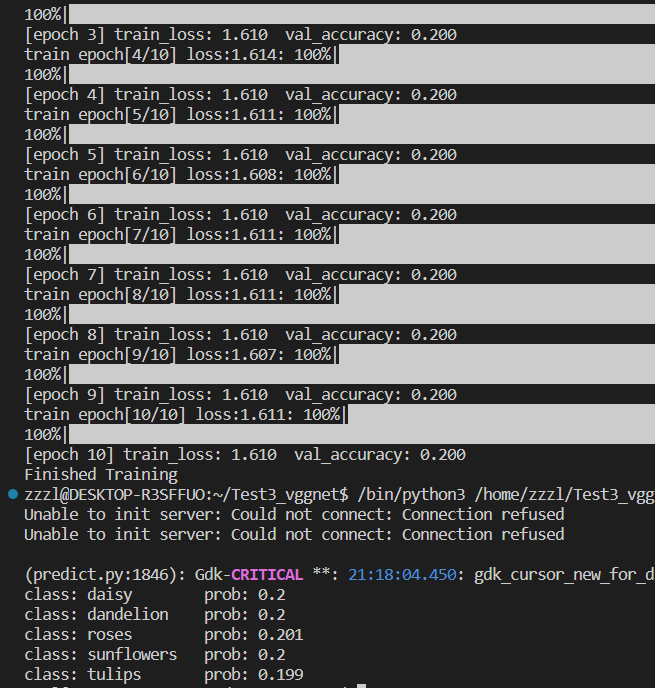前言:
参考内容来自up:4.1 VGG网络详解及感受野的计算_哔哩哔哩_bilibili
一、简介
VGG 在2014年由牛津大学著名研究组 VGG(Visual Geometry Group)提出,斩获该年 ImageNet 竞赛中 Localization Task(定位任务)第一名和 Classification Task(分类任务)第二名。
原论文地址:[1409.1556] Very Deep Convolutional Networks for Large-Scale Image Recognition (arxiv.org)
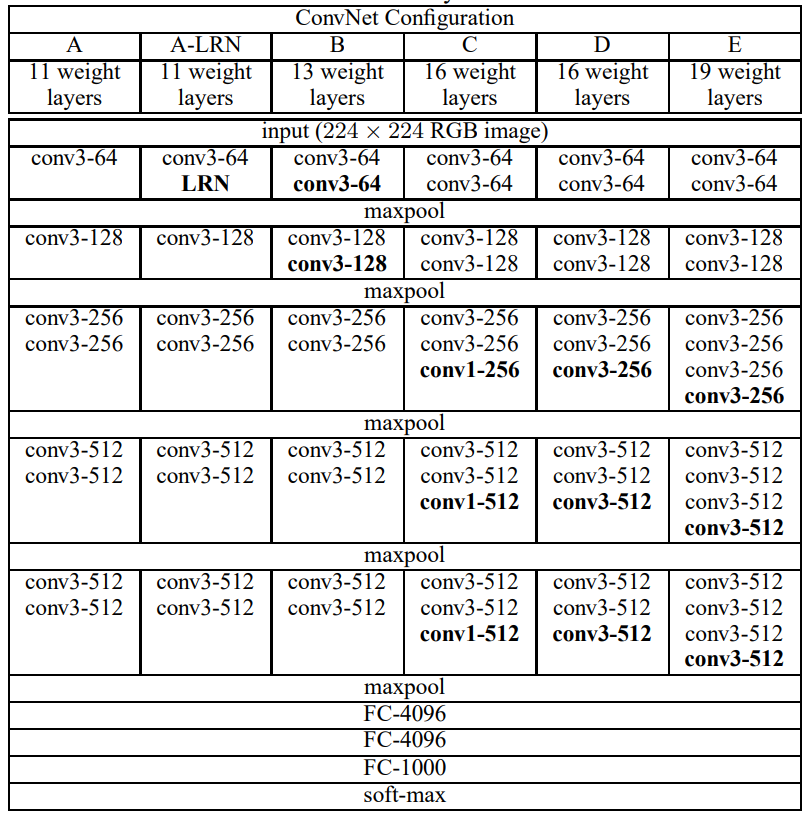
VGG网络的创新点:通过堆叠多个小卷积核来替代大尺度卷积核,可以减少训练参数,同时能保证相同的感受野。
论文中提到,可以通过堆叠两个3×3的卷积核替代5x5的卷积核,堆叠三个3×3的卷积核替代7x7的卷积核,这样做可以拥有相同的感受野 。
二、详解
1. CNN感受野
在卷积神经网络中,决定某一层输出结果中一个元素所对应的输入层的区域大小,被称作感受野(receptive field)。
通俗的解释是,输出feature map上的一个单元 对应输入层上的区域大小。
以下图为例,输出层 layer3 中一个单元 对应 输入层 layer2 上区域大小为2×2(池化操作),对应输入层 layer1 上大小为5×5
(可以这么理解,layer2中 2×2区域中的每一块对应一个3×3的卷积核,又因为 stride=2,所以layer1的感受野为5×5)
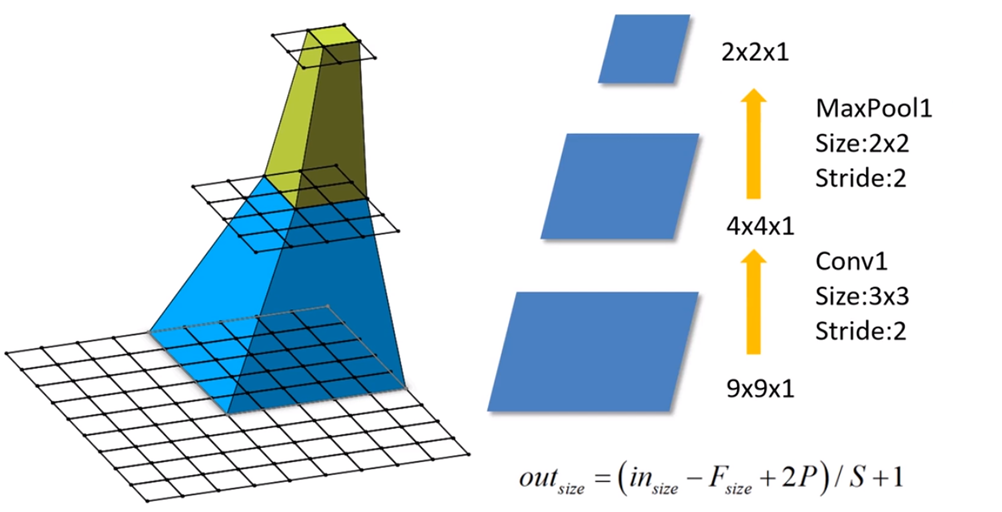
感受野的计算公式为:
F(i)=( F (i +1)−1) × Stride +Ksize
- F(i) 为第 i 层感受野
- Stride 为第 i 层的步距
- Ksize 为 卷积核或池化核尺寸
以上图为例:
Feature map: F(3) = 1
Pool1:F ( 2 ) = ( 1 − 1 ) × 2 + 2 = 2
Conv1: F ( 1 ) = ( 2 − 1 ) × 2 + 3 = 5
2. 多个小卷积核
验证一下VGG论文中的两点结论:
1.堆叠两个3×3的卷积核替代5x5的卷积核,堆叠三个3×3的卷积核替代7x7的卷积核。替代前后感受野是否相同?
(注:VGG网络中卷积的Stride默认为1)
Feature map: F = 1
Conv3x3(3): F = ( 1 − 1 ) × 1 + 3 = 3
Conv3x3(2): F = ( 3 − 1 ) × 1 + 3 = 5 (5×5卷积核感受野)
Conv3x3(1): F = ( 5 − 1 ) × 1 + 3 = 7 (7×7卷积核感受野)
2.堆叠3×3卷积核后训练参数是否真的减少了?
注:CNN参数个数 = 卷积核尺寸×卷积核深度 × 卷积核组数 = 卷积核尺寸 × 输入特征矩阵深度 × 输出特征矩阵深度
现假设:输入特征矩阵深度 = 输出特征矩阵深度 = C
使用7×7卷积核所需参数个数:
![]()
堆叠三个3×3的卷积核所需参数个数:
![]()
3. VGG-16
VGG网络有多个版本,一般常用的是VGG-16模型,其网络结构如下如所示
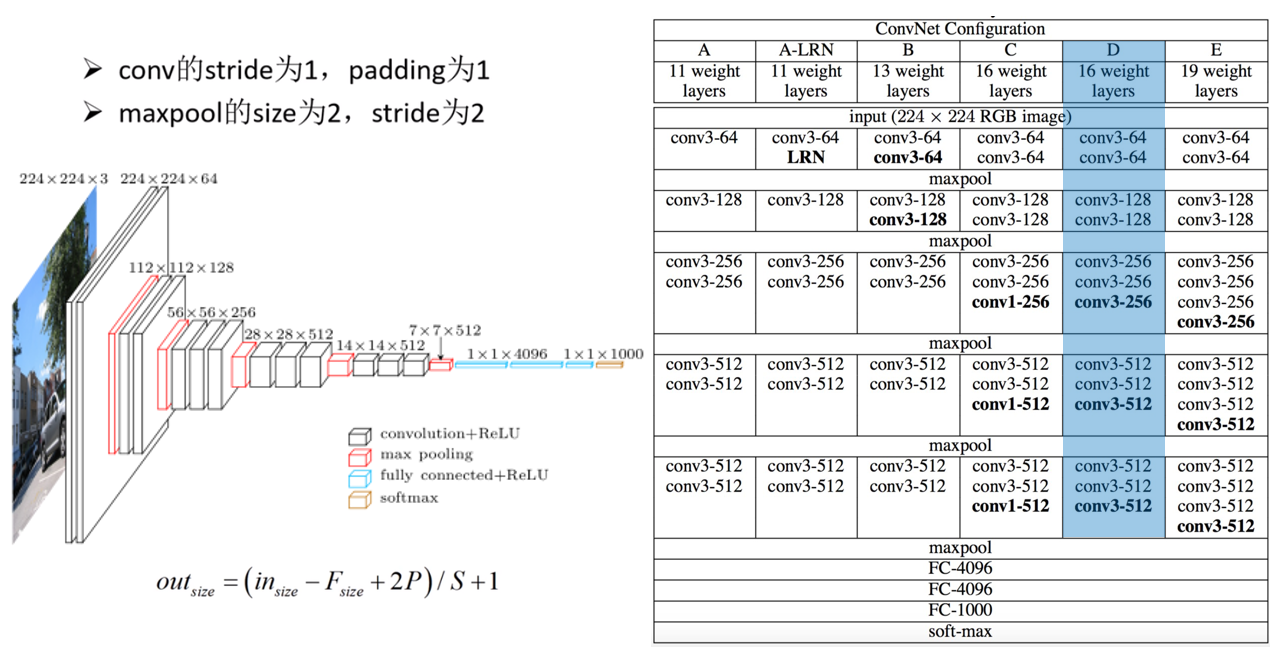
16层分别为:13个卷积层和3个全连接层
经3×3卷积的特征矩阵的尺寸是不改变的:

因为maxpool的池化和大小和步距为2,所以图像缩小为原来的一半
如下图所示,channel会根据上一层的卷积核个数变化,每经过一次maxpool,图像的长宽都会缩小为原来的一半
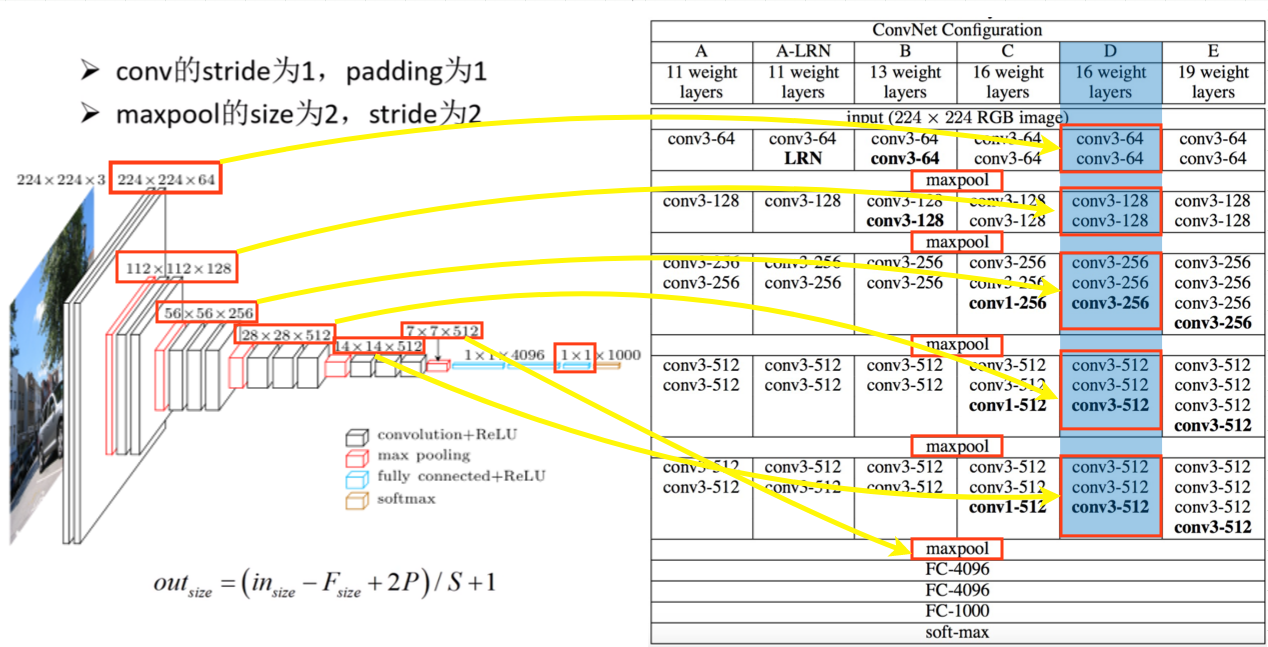
全连接层3有1000个节点,因为分类任务有一千类别,最后一层不需要Relu激活函数,因为最后要经过一次softmax函数。
三、代码复现
接下来搭建A,B,D,E四个配置模型
将VGG网络分为两个部分:提取特征网络结构和分类网络结构
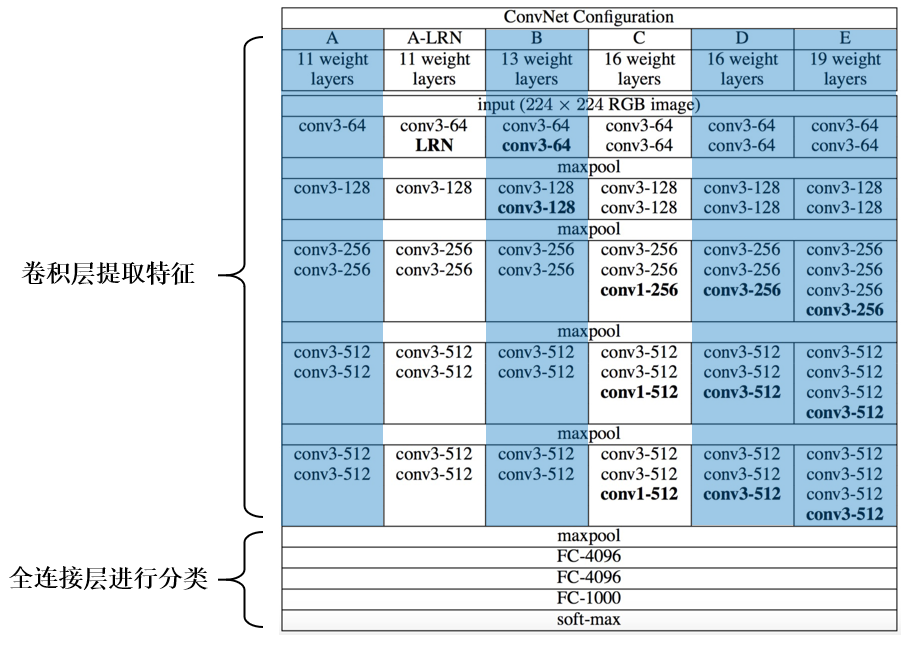
1. model.py
定义一个字典文件,字典的每个key代表一个模型的配置文件
cfgs = {
'vgg11': [64, 'M', 128, 'M', 256, 256, 'M', 512, 512, 'M', 512, 512, 'M'],
'vgg13': [64, 64, 'M', 128, 128, 'M', 256, 256, 'M', 512, 512, 'M', 512, 512, 'M'],
'vgg16': [64, 64, 'M', 128, 128, 'M', 256, 256, 256, 'M', 512, 512, 512, 'M', 512, 512, 512, 'M'],
'vgg19': [64, 64, 'M', 128, 128, 'M', 256, 256, 256, 256, 'M', 512, 512, 512, 512, 'M', 512, 512, 512, 512, 'M'],
}如:VGG11,对应的值是一个列表,数字代表卷积核的个数,M代表池化层的结构,与上图中的结构一一对应
Sequential类的使用示例:
- #通过将一个个非关键参数输入到Sequential类中,从而生成新的网络层结构
model = nn.Sequential(
nn.Conv2d(1,20,5),
nn.ReLU(),
nn.Conv2d(20,64,5),
nn.ReLU()
)- 通过有序字典的方式输入
model = nn.Sequential(OrderedDict([
('conv1', nn.Conv2d(1,20,5)),
('relu1', nn.ReLU()),
('conv2', nn.Conv2d(20,64,5)),
('relu2', nn.ReLU())
]))参考:Python 函数参数前面一个星号(*)和两个星号(**)的区别
完整代码:
import torch.nn as nn
import torch
# official pretrain weights
model_urls = {
'vgg11': 'https://download.pytorch.org/models/vgg11-bbd30ac9.pth',
'vgg13': 'https://download.pytorch.org/models/vgg13-c768596a.pth',
'vgg16': 'https://download.pytorch.org/models/vgg16-397923af.pth',
'vgg19': 'https://download.pytorch.org/models/vgg19-dcbb9e9d.pth'
}
class VGG(nn.Module):
#传入提取特征网络结构,init_weights表示是否对权重进行初始化
def __init__(self, features, num_classes=1000, init_weights=False):
super(VGG, self).__init__()
self.features = features
#全连接层分类,提取特征得到的时7*7*512,要先进行展平处理才能进行分类
self.classifier = nn.Sequential(
nn.Linear(512*7*7, 4096),
nn.ReLU(True),
nn.Dropout(p=0.5),
nn.Linear(4096, 4096),
nn.ReLU(True),
nn.Dropout(p=0.5),
nn.Linear(4096, num_classes)
)
#是否对网络参数初始化
if init_weights:
self._initialize_weights()
#正向传播
def forward(self, x):
# N x 3 x 224 x 224
x = self.features(x)
# N x 512 x 7 x 7,展平操作,从第一个维度开始
x = torch.flatten(x, start_dim=1)
# N x 512*7*7
x = self.classifier(x)
return x
#初始化参数
def _initialize_weights(self):
for m in self.modules():
if isinstance(m, nn.Conv2d):
# nn.init.kaiming_normal_(m.weight, mode='fan_out', nonlinearity='relu')
nn.init.xavier_uniform_(m.weight)
if m.bias is not None:
nn.init.constant_(m.bias, 0)
elif isinstance(m, nn.Linear):
nn.init.xavier_uniform_(m.weight)
# nn.init.normal_(m.weight, 0, 0.01)
nn.init.constant_(m.bias, 0)
# 卷积层提取特征
def make_features(cfg: list): #提取特征的函数,使用时只需要传入对应的列表
layers = [] #定义一个空列表存放我们定义的每一层结构
in_channels = 3 #彩色图像,channel为3
for v in cfg: #遍历配置列表
if v == "M":
layers += [nn.MaxPool2d(kernel_size=2, stride=2)] #创建最大池化下采样层
else: #卷积层
conv2d = nn.Conv2d(in_channels, v, kernel_size=3, padding=1)
#第一层时彩色图像in_channels=3,v=64个卷积核
layers += [conv2d, nn.ReLU(True)] #将刚刚定义的卷积层和Relu激活函数拼接在一起,添加到layers列表中
in_channels = v #特征矩阵经过该层卷积之后,输出的深度变成v
return nn.Sequential(*layers) #将列表通过非关键字的形式传入
#定义一个字典文件,字典的每个key代表一个模型的配置文件
cfgs = {
'vgg11': [64, 'M', 128, 'M', 256, 256, 'M', 512, 512, 'M', 512, 512, 'M'],
'vgg13': [64, 64, 'M', 128, 128, 'M', 256, 256, 'M', 512, 512, 'M', 512, 512, 'M'],
'vgg16': [64, 64, 'M', 128, 128, 'M', 256, 256, 256, 'M', 512, 512, 512, 'M', 512, 512, 512, 'M'],
'vgg19': [64, 64, 'M', 128, 128, 'M', 256, 256, 256, 256, 'M', 512, 512, 512, 512, 'M', 512, 512, 512, 512, 'M'],
}
#实例化vgg网络
def vgg(model_name="vgg16", **kwargs):
assert model_name in cfgs, "Warning: model number {} not in cfgs dict!".format(model_name)
cfg = cfgs[model_name] #得到cfg
model = VGG(make_features(cfg), **kwargs) #**kwargs可变长度的字典变量
return model2. train.py
import os
import sys
import json
import torch
torch.cuda.current_device()
import torch.nn as nn
from torchvision import transforms, datasets
import torch.optim as optim
from tqdm import tqdm
from model import vgg
def main():
device = torch.device("cuda:0" if torch.cuda.is_available() else "cpu")
print("using {} device.".format(device))
data_transform = {
"train": transforms.Compose([transforms.RandomResizedCrop(224),
transforms.RandomHorizontalFlip(),
transforms.ToTensor(),
transforms.Normalize((0.5, 0.5, 0.5), (0.5, 0.5, 0.5))]),
"val": transforms.Compose([transforms.Resize((224, 224)),
transforms.ToTensor(),
transforms.Normalize((0.5, 0.5, 0.5), (0.5, 0.5, 0.5))])}
data_root = os.path.abspath(os.path.join(os.getcwd(), "../")) # get data root path
image_path = os.path.join(data_root, "data_set", "flower_data") # flower data set path
assert os.path.exists(image_path), "{} path does not exist.".format(image_path)
train_dataset = datasets.ImageFolder(root=os.path.join(image_path, "train"),
transform=data_transform["train"])
train_num = len(train_dataset)
# {'daisy':0, 'dandelion':1, 'roses':2, 'sunflower':3, 'tulips':4}
flower_list = train_dataset.class_to_idx
cla_dict = dict((val, key) for key, val in flower_list.items())
# write dict into json file
json_str = json.dumps(cla_dict, indent=4)
with open('class_indices.json', 'w') as json_file:
json_file.write(json_str)
batch_size = 4
nw = min([os.cpu_count(), batch_size if batch_size > 1 else 0, 8]) # number of workers
print('Using {} dataloader workers every process'.format(nw))
train_loader = torch.utils.data.DataLoader(train_dataset,
batch_size=batch_size, shuffle=True,
num_workers=nw)
validate_dataset = datasets.ImageFolder(root=os.path.join(image_path, "val"),
transform=data_transform["val"])
val_num = len(validate_dataset)
validate_loader = torch.utils.data.DataLoader(validate_dataset,
batch_size=batch_size, shuffle=False,
num_workers=nw)
print("using {} images for training, {} images for validation.".format(train_num,
val_num))
# test_data_iter = iter(validate_loader)
# test_image, test_label = test_data_iter.next()
model_name = "vgg16"
net = vgg(model_name=model_name, num_classes=5, init_weights=True)
net.to(device)
loss_function = nn.CrossEntropyLoss()
optimizer = optim.Adam(net.parameters(), lr=0.0001)
epochs = 10
best_acc = 0.0
save_path = './{}Net.pth'.format(model_name)
train_steps = len(train_loader)
for epoch in range(epochs):
# train
net.train()
running_loss = 0.0
train_bar = tqdm(train_loader, file=sys.stdout)
for step, data in enumerate(train_bar):
images, labels = data
optimizer.zero_grad()
outputs = net(images.to(device))
loss = loss_function(outputs, labels.to(device))
loss.backward()
optimizer.step()
# print statistics
running_loss += loss.item()
train_bar.desc = "train epoch[{}/{}] loss:{:.3f}".format(epoch + 1,
epochs,
loss)
# validate
net.eval()
acc = 0.0 # accumulate accurate number / epoch
with torch.no_grad():
val_bar = tqdm(validate_loader, file=sys.stdout)
for val_data in val_bar:
val_images, val_labels = val_data
outputs = net(val_images.to(device))
predict_y = torch.max(outputs, dim=1)[1]
acc += torch.eq(predict_y, val_labels.to(device)).sum().item()
val_accurate = acc / val_num
print('[epoch %d] train_loss: %.3f val_accuracy: %.3f' %
(epoch + 1, running_loss / train_steps, val_accurate))
if val_accurate > best_acc:
best_acc = val_accurate
torch.save(net.state_dict(), save_path)
print('Finished Training')
if __name__ == '__main__':
main()
训练脚本跟上一篇AlexNet基本一致
函数调用过程:
net = vgg(model_name="vgg16", num_classes=5, init_weights=True)
cfg = cfgs[model_name]
= cfgs[vgg16] = [64, 64, 'M', 128, 128, 'M', 256, 256, 256, 'M', 512, 512, 512, 'M', 512, 512, 512, 'M']
model = VGG(make_features(cfg), num_classes=5, init_weights=True)
make_features(cfg: list)
3. predict.py
import os
import json
import torch
from PIL import Image
from torchvision import transforms
import matplotlib.pyplot as plt
from model import vgg
def main():
device = torch.device("cuda:0" if torch.cuda.is_available() else "cpu")
data_transform = transforms.Compose(
[transforms.Resize((224, 224)),
transforms.ToTensor(),
transforms.Normalize((0.5, 0.5, 0.5), (0.5, 0.5, 0.5))])
# load image
img_path = "../tulip.jpg"
assert os.path.exists(img_path), "file: '{}' dose not exist.".format(img_path)
img = Image.open(img_path)
plt.imshow(img)
# [N, C, H, W]
img = data_transform(img)
# expand batch dimension
img = torch.unsqueeze(img, dim=0)
# read class_indict
json_path = './class_indices.json'
assert os.path.exists(json_path), "file: '{}' dose not exist.".format(json_path)
with open(json_path, "r") as f:
class_indict = json.load(f)
# create model
model = vgg(model_name="vgg16", num_classes=5).to(device)
# load model weights
weights_path = "./vgg16Net.pth"
assert os.path.exists(weights_path), "file: '{}' dose not exist.".format(weights_path)
model.load_state_dict(torch.load(weights_path, map_location=device))
model.eval()
with torch.no_grad():
# predict class
output = torch.squeeze(model(img.to(device))).cpu()
predict = torch.softmax(output, dim=0)
predict_cla = torch.argmax(predict).numpy()
print_res = "class: {} prob: {:.3}".format(class_indict[str(predict_cla)],
predict[predict_cla].numpy())
plt.title(print_res)
for i in range(len(predict)):
print("class: {:10} prob: {:.3}".format(class_indict[str(i)],
predict[i].numpy()))
plt.show()
if __name__ == '__main__':
main()
我这里减少图片数量进行训练,得到很低的准确率
